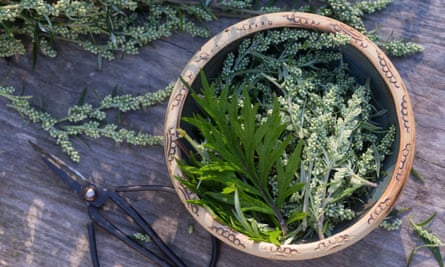Mugwort is a wild thing that loves our edges, from paths and urban riverbanks to feral car-park corners and wastelands. Its leaves, with their silvery undersides and feathery plumes of flowers, thrive in these seemingly inhospitable conditions: I’m not sure I’d recommend you plant it in your garden, but if you live near such places, you may find it appears anyway.
Mugwort, Artemisia vulgaris, has a long history of being a powerful, protective herb, used to treat everything from malaise to irregular periods, and to flavour many a brewing experiment (it was one of the most common flavourings for beer until hops took over in the 16th century).
One of the joys of mugwort is you can pick it from very early spring right into autumn. In the early part of the year, you can use all parts of the soft growth, but by later summer, when the stem has toughened and it is in flower, pick only the leaves. You can also hang whole stems of mugwort upside down to dry and use over winter.
In Marie Viljoen’s book, Forage, Harvest, Feast: A Wild-Inspired Cuisine, she makes a strong case for mugwort as a chief ingredient for homemade vermouth, made by infusing vodka with mulberries and raspberries, mugwort, lemon peel and foraged spices, then using this to fortify white wine to create a local seasonal drink – truly next-level foraging.
For an easier introduction to the rosemary and sage notes of mugwort, try making herb salt, where you wash and dry the leaves and mix with sea salt, roughly one part chopped leaf to six parts salt. Dry for a further day before storing in an airtight container.
You can also make savoury crackers, shortbread or cheese scones with mugwort. Use fresh leaves, chopped flowers and, for added intensity, mugwort salt. They are very moreish.

It’s also good in egg dishes, as flavouring for baked tomatoes, in roasted garlic paste, and with pork, lamb and beef. There are numerous Asian dishes too, from mugwort-flavoured rice balls and mochi in Japan to soups, stews, salads and dumplings in Korea, China and Taiwan. The genus Artemisia has many useful species: tarragon (A. dracunculus ), wormwood (A. absinthium), white sage (A. ludoviciana) and Yomogi (A. princeps) to name a few.
If you want to grow your own mugwort, try the variegated form of A. vulgaris ‘Oriental Limelight’. It’s a pretty questionable variegation – white, lime-yellow and green in large splashes – but its tough nature means it is one of those things that will happily grow in the dry, dappled shade of a deciduous tree – right where many others things won’t.

Comments (…)
Sign in or create your Guardian account to join the discussion